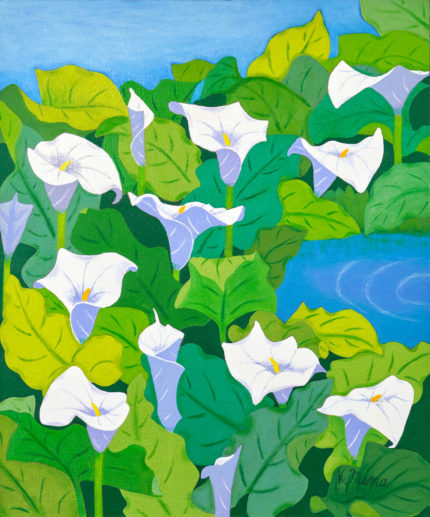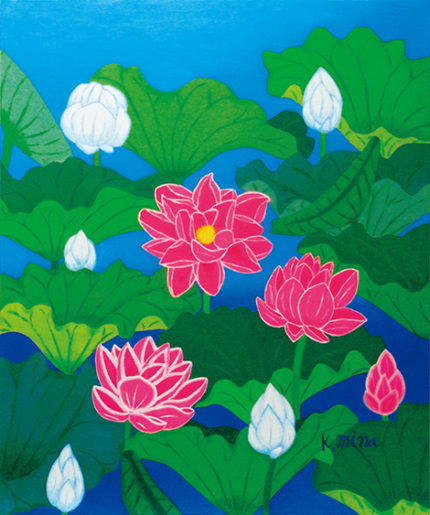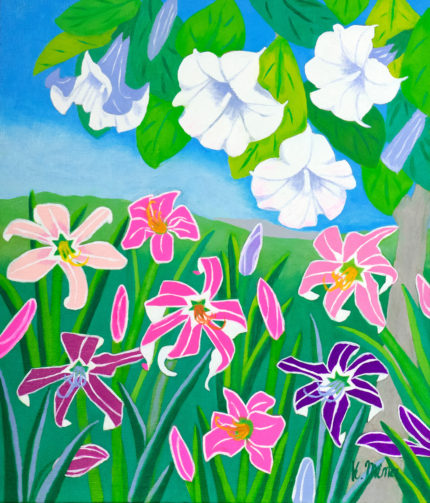- JEPAA Member

- Western-style paint
- Mina Kikuchi
- 洋画
- 菊池三奈
© 2024 Mina Kikuchi.
SCROLL
Portfolio /作品
- カラー群生/rainbow-colored plants
- 古代ハス/ancient lotus
- 自己紹介 私エンゼル 私ヘメロカリス/Introduce yourself, I am Angel, I am Hemerocallis.
Interview article /対談記事
2023年特別対談 菊池三奈×ジョゼフ・バルバラ
花を通して描き出される
色彩美の精神世界

ジョゼフ・バルバラ(以下 ジョゼフ):菊池先生の 作品はマルタでも拝見していました。今回も美しい作 品を出してくださっていますね。こちらのタイトルは 『エンゼル』ですが、どのような思いが込められている のでしょうか?
菊池三奈(以下 菊池):そうですね、実は『エンゼ ル』という名前もふっと閃いたもので、はっきりとし た理由はないんです。ただタイトルも作品の一部と考 えているので、自分でもこれが絵の雰囲気に一番ふさわしいものだと直感したのかもしれません。
ジョゼフ:そうなのですね。私はこの作品の中に天使 に結びつくものが描かれているのかと思っていまし た。しかし菊池先生はそうした枠にとらわれず、もっ と心の深い部分のインスピレーションで考えられたの ですね。 ところでこの作品は色が印象的ですが、材料は何を使 われているんですか?
菊池:使っているのは油絵の具です。私は濁った色が 嫌いで、できるだけ鮮明な色彩を理想としています。 ただ油絵は色を混ぜて描くのが普通なので、敢えて色 同士を混ぜない表現をしたら面白いのではないかと考えて、今のスタイルになりました。ただ混色ではあり ませんが、下地にキャンバスを黒一色で塗り、乾い たらその上から青、さらに赤と塗り重ねます。そうす ることで下地の印象が浮き上がってくるんです。それ と、線をはっきり描くことも意識しています。日本画 は線一本で様々な表現を可能にしていますが、私もそれを自分の絵で再現していきたいと思っております。
ジョゼフ:確かに色それぞれがクリアでしっかりして います。3 年前、マルタで見た作品もそれが印象的で した。それと線がきれいに描写されていますね。こう した表現をやっていこうと思われたのは、何かきっか けや理由などもあったのでしょうか?
菊池:もともと日本画が好きというのはありますね。 そして色をクリアに、線をはっきりと描いた方が、花 たちが画面上から浮き上がってくるように見えてくる んです。私の絵を平面的と感じる方もいらっしゃるか もしれませんが、今のスタイルの方が立体感はあると 私は考えています。
ジョゼフ:確かにこの方が、奥行きがあると言うか、 より浮き上がってくるように見えますね。画家として 経験値が積み上がっているからこそ、このような表現 の個性や幅が確立され、絵画としての力が磨かれるの だと思います。 菊池:ありがとうございます。
ジョゼフ:菊池先生が芸術の目で世界を見ると、花た ちが独自に命を持ったように動き出していくものとし て捉えられているのではないでしょうか。作品を見て いると、花というものを先生がそのように解釈されて いるのではないかと考えていました。
菊池:その通りですね。制作する際は、いつもどこか で咲いている花を見て、写真を撮って、それからキャンバスに向かいます。構図は自分の頭の中で組み立て て、色は自分が良いと思ったものを選んでいきます。
ジョゼフ:その時に感じた印象やアイディアをそのま ま形にしているのですね。
菊池:そうですね、そのせいか買ってきた花、切り花 などは描けません。まず自分が外に出て花を見るとこ ろから制作が始まっているのでしょうね。
ジョゼフ:それは単にたくさんの花を見ているわけで はなく、その時の記憶や思い出がプラスされた光景を イメージして、絵に表現されようとしているからでは ないでしょうか。
菊池:あぁ、まさにその通りです。ですから、きれい な花を描いているはずなのに、出来上がった作品をふ と振り返って見たら「怖い」と思ったことがありま す。それは絵を見てくれた他の方からもそう言われた ので、自分自身の印象や思い出が加味された結果、そういう作品になったのでしょうね。
ジョゼフ:気持ちや印象などの表現が優れているとい うことでもあると思いますよ。ちなみに菊池先生は、 これまで一貫して花をモチーフにされていたのです か? 菊池:以前は裸婦や静物画なども描いておりました。 ただ私が所属する美術協会の先生から花の絵を褒めて いただいたり、同じ教室の先輩から「あなたは花を描 いた方がいい。花を描くべき」と仰っていただいたり したんです。その時の印象が強く残っていて、花に専 念するようになりました。
ジョゼフ:現在の活躍を見れば、その言葉は正しかっ たと思います。
菊池:ありがとうございます。私ももし機会があれば マルタに行ってみたいです。古い街並みの美しさな ど、実物を見られたらいいなと思います。
ジョゼフ:菊池先生の作品はマルタでも多くの方が足 を止めて鑑賞していました。もし来てくれたら、多く のマルタの人々が喜ぶでしょう。今日はありがとうご ざいました。
2023 Special Talk Session Mina Kikuchi ×Joseph Barbara
Spiritual worlds of glorious color depicted through flowers
Joseph Barbara: Ms. Kikuchi, I’ve seen your work before in Malta. And now you’ve created another beautiful piece. The title of this one is “Angel.” What kind of feelings does this title convey?
Mina Kikuchi: Well, actually, the title “Angel” just came to me in a flash. I don’t have a clear rationale for it. But I consider the title to be a part of the work, so perhaps it was an intuition that this was the most appropriate way to describe the atmosphere of the painting. Joseph: I see. I’d thought there might be something depicted in this work that was connected to angels. However, you weren’t bound by this frame of reference, but instead found inspiration in a deeper part of your heart. By the way, the colors in this work are most impressive. What media did you use?
Kikuchi: I used oil paints. I dislike muddy colors, and ideally, I try to make the colors as vivid as possible. Oil paintings are usually painted by mixing colors, but I thought I’d dare to try expressing myself without mixing any colors. This is how I arrived at my current style. I paint the canvas in black as a base color, and after drying it, I paint blue, then red, and so on in layers. This really draws out the underlying color, bringing it to the surface. I’m also very conscious of drawing lines clearly. In traditional Japanese paintings, all kinds of expressions are possible with a single line, and I try to reproduce this aspect in my paintings.
Joseph: Each color is certainly clear and vivid. The colors of your work I saw in Malta three years ago were impressive as well. Your lines are also beautifully rendered. Was there any particular reason or impetus that made you decide to pursue this form of expression?
Kikuchi: I’ve always loved traditional Japanese paintings. And I think that the clearer the colors and the clearer the lines, the more the flowers seem to jump out from the plane of the picture. Some may think my paintings are flat, but I believe my current style has more of a three dimensional feeling.
Joseph: It’s true that it has more depth, and it seems to leap out more. I think that having gained so much experience as a painter, you could establish your individuality and range of expression like this, and you will keep honing your skill as a painter.
Kikuchi: Thank you very much.
Joseph: Looking at the world through the lens of art, you see flowers as something moving, animated, with a life of their own, I suppose. When I see your works, I wonder whether that’s perhaps how you interpret flowers?
Kikuchi: You’re right. When I start working, I always look at flowers blooming somewhere, take a picture of them, and then paint a canvas. I build up the composition in my head, and I choose colors that I think will be good.
Joseph: So, you just give shape to the impressions and ideas you felt at the time?
Kikuchi: Yes. And perhaps that’s why I can’t paint cut flowers or flowers purchased in a shop. I guess my work truly begins when I go outside to look at the flowers.
Joseph: I think maybe it’s because you’re not simply looking at a lot of flowers — you’re trying to express through your paintings an image of the scene that incorporates your memories and feelings at that time.
Kikuchi: Oh, that’s exactly right. It’s happened before — I painted a beautiful flower, but when I looked back at the finished work, I thought, “That’s a bit frightening.” That’s what other people looking at my paintings have told me, so I guess my own impressions and memories were added to the piece, and that’s how it came to be.
Joseph: I think it also indicates your great ability to express feelings, impressions, and so on. Incidentally, have flowers been a consistent motif in your work?
Kikuchi: Previously, I used to paint nudes and still life paintings. However, a teacher in the art association I belong to praised my flower paintings, and a student in the same class said to me, “You should paint flowers.” It made a powerful impression on me, and I began to devote myself to painting flowers.
Joseph: Looking at your current activities, I think those words were very fitting.
Kikuchi: Thank you very much. I’d love to visit Malta if I get the chance. It would be wonderful to witness the beauty of those old buildings in person.
Joseph: Many people in Malta stopped to admire your work. I’m sure many Maltese people will be glad if you come to Malta. Thank you very much for your time today.
Solo Exhibition /個展
特設個展ブースin 日欧宮殿芸術祭2021
会期:2021年6月4日~6日
会場:シャルロッテンブルク宮殿(ドイツ・ベルリン)
主催:一般社団法人 日欧宮殿芸術協会
運営:クリエイト・アイエムエス株式会社
Solo Exhibition in JEPAA Festival 2021
Date: June 4th – 6th, 2021
Venue: Charlottenburg Palace, Berlin, Germany
Organizer: Japan-Europe Palace Art Association
Operated by: Create IMS Co., Ltd.
Profile /経歴
菊池三奈 Mina Kikuchi
1935年 東京都出身
三軌会会友
作品出展国遍歴(JEPAA関連事業):ドイツ、フランス、イタリア、カナダ他
Born: 1935 Tokyo, Japan
Affiliated Group:SANKI-KAI exhibition fellow
Exhibition of Works(JEPAA): Germany, France, Italy, Canada…







